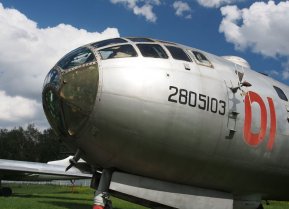North American B-45 Tornado: A Bomber That Made Some Serious History
The North American Aviation B-45, which made its first flight in March 1947, achieved a slew of firsts.
There is no denying that American airpower played a crucial role in bringing Nazi Germany and the Empire of Japan to their proverbial knees. American bombers including the B-17 and B-24 dominated the skies over Germany and Japan – but by war's end, both were clearly aging technologies. Even the B-29, which carried the atomic bombs were used on Japan, was designed before the United States entered the war.
In 1944, the U.S. Army Air Corps faced a threat from the German jet aircraft including a jet bomber and issued a design competition for a jet-powered bomber. The U.S. War Department set forth a number of requirements for the bomber, but the war ended before much progress was made. Efforts to develop a jet bomber were further delayed by post-war cutbacks, but as tensions with the Soviet Union mounted it became apparent that a jet bomber was necessary.
The North American Aviation B-45, which made its first flight in March 1947, achieved a slew of firsts.
It was the first four-engine jet bomber to fly, the first American production jet bomber, the first jet bomber capable of carrying an atomic bomb and the first multi-jet reconnaissance aircraft to refuel in mid-air.
North American built 142 B-45 bombers including 10 long-range B-45Cs, which featured wingtip fuel tanks, and 33 RB-45Cs that were configured for high-altitude photo-reconnaissance and aerial refueling.
The aircraft was light on armament with just two .50 caliber machine guns in the tail, but it could carry 22,000 pounds of bombs – essentially making it a light bomber. It was powered by four General Electric J47 engines that each provided 6,000 pounds of thrust. The B-45 had a maximum speed of 570 mph and a range of 1,000 miles with a ceiling of 37,500feet.
The aircraft was an important part of the United States' nuclear deterrent for several years in the early 1950s until the bombers were replaced by the Boeing B-47 Stratojet. The B-45 saw service in the Korean War where it proved its value as both a bomber and as a high-altitude reconnaissance aircraft and was able to outrun and outmaneuver the enemy's MiG fighters. Both the B-45 and RB-45C served in the United States Air Force's Strategic Air Command from 1950 until 1959; while from 1952-58, B-45s of the 47th Bomb Wing (Light) and RB-45s from the USAF 19th Tactical Reconnaissance Squadron and Royal air Force (RAF) Special Duty Flight crews were based at RAF Sculthorpe, England. The RAF-crewed RB-45 aircraft flew highly classified missions deep into the Iron Curtain.
The Tornado played an important role with the U.S. Air Force in the early stages of the Cold War, with some 143 of the aircraft produced. Today only three Tornados still exist in presentation form including one at the National Museum of the United States Air Force in Dayton, Ohio.
Peter Suciu is a Michigan-based writer who has contributed to more than four dozen magazines, newspapers and websites. He is the author of several books on military headgear including A Gallery of Military Headdress, which is available on Amazon.com.


